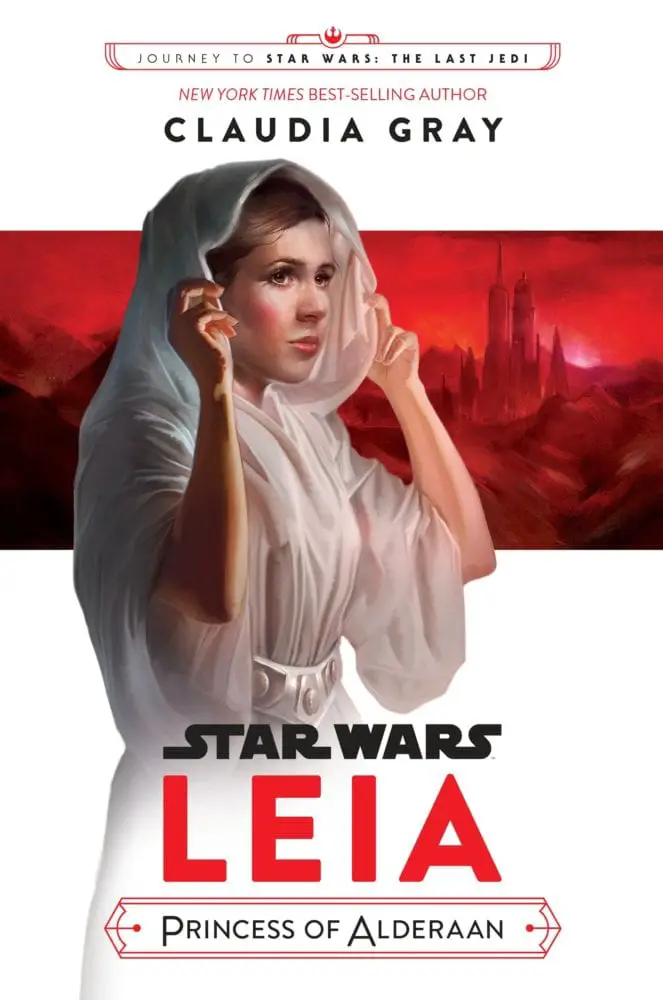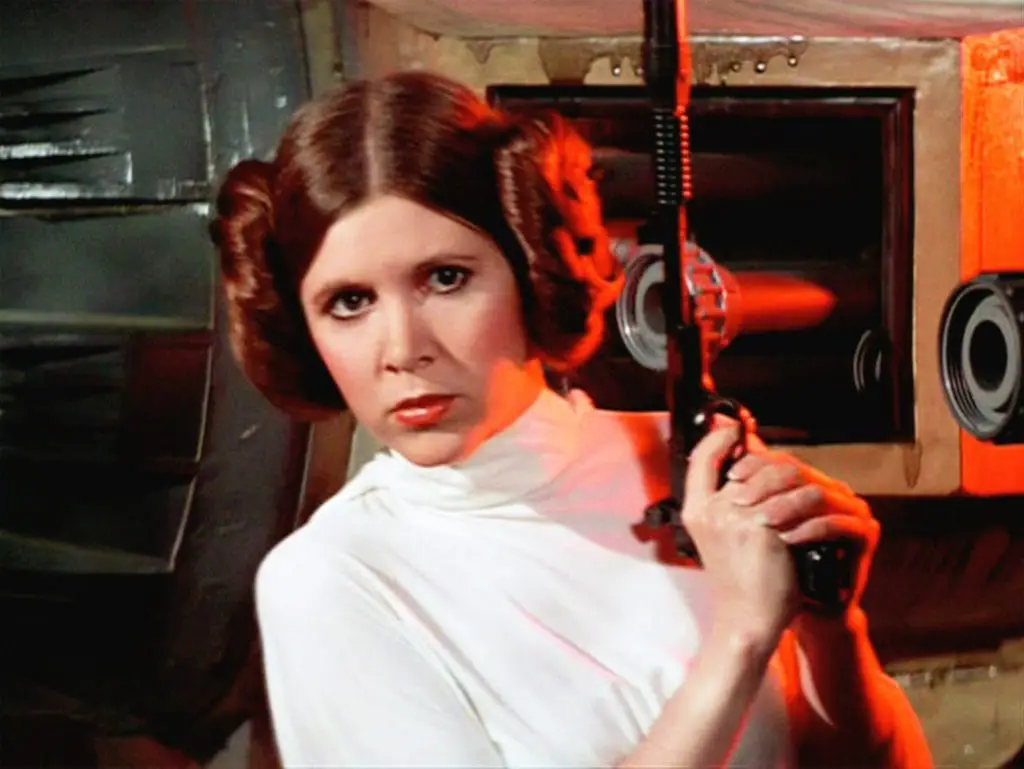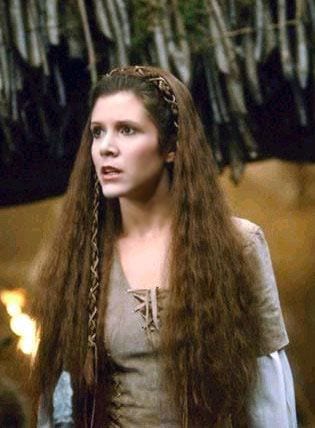I admit, I’m a sucker for anything Leia related. She’s my favorite character in the entire Star Wars franchise (sorry, Doctor Aphra, but you will always come in second). That being said, Claudia Grays new YA novel Leia: Princess of Alderaan (hereafter PoA) blew me away. And I already loved Bloodline, Gray’s novel about middle-aged Leia set not long before Star Wars: The Force Awakens. I didn’t think Gray could prove to me even more how much she understands Julia’s, Kylie’s, and my perceptions of Dutiful Princess Leia after Bloodline. And then she wrote this.
PoA is stunningly in character, character driven, and rich. I know for a fact that I’ll be reading it again and again, and that’s not something I normally say about YA novels. There are deep, multi-layered relationships between female characters, complicated family dynamics, a shit-ton of pre-A New Hope era worldbuilding, and plenty of easter eggs for more dedicated Star Wars fans (Krennic anyone?). In short, it’s one of the best damn Star Wars novels of New Canon and a must-read for any Leia fan.
A (Brief) Spoiler Free Rundown
 Sixteen-year-old Princess Leia Organa faces the most challenging task of her life so far: proving herself in the arena of body, mind, and heart to be formally named heir to the throne of Alderaan. She’s taking rigorous survival courses, practicing politics, and spearheading relief missions to world under Imperial control.
Sixteen-year-old Princess Leia Organa faces the most challenging task of her life so far: proving herself in the arena of body, mind, and heart to be formally named heir to the throne of Alderaan. She’s taking rigorous survival courses, practicing politics, and spearheading relief missions to world under Imperial control.
But Leia has worries beyond her claim to the crown. Her parents, Breha and Bail, aren’t acting like themselves lately; they are distant and preoccupied, seeming more concerned with throwing dinner parties for their allies in the Senate than they are with their own daughter. Determined to uncover her parents’ secrets, Leia starts down an increasingly dangerous path that puts her right under the watchful eye of the Empire. And when Leia discovers what her parents and their allies are planning behind closed doors, she finds herself facing an impossible choice: dedicate herself to the people of Alderaan—including the man she loves—or to the galaxy at large, which is in desperate need of a rebel hero…
The Good Stuff
Fair warning, I’m going to gush. A lot. You can tap out of my fangirling whenever you want, but I have so much to say about this book that I couldn’t cut anything. Think of it as more of a book analysis than a strict review, if that helps.
PoA is not a traditional YA novel, though my opinion on that might stem from having mostly read YA dystopian novels in the past few years. For starters, Gray utilizes third person intimate narrative perspective rather than first person. I find the choice not only refreshing but fitting. Third person intimate offers all the benefits of first person—close, visceral engagement with Leia’s feelings and thoughts—without the drawbacks of a potentially boring or annoying headspace. (Not that Leia would have either of those, but still.) We experience Leia’s struggles with her, but we get to see beyond that as well.
Leia’s Character Arc
PoA is almost entirely character driven rather than being a rapid-fire action story like the Abyss duology. Leia’s internal conflict acts as the major motivating factor for the plot rather than the plot itself. The Challenges of Heart, Mind, and Body she must accomplish to be invested as official heir to Alderaan exist to contextualize and further develop Leia’s psychological and emotional struggles with her parents’, and eventually her own, involvement with the budding rebellion against the Empire.
It’s a character study of teenage Leia, a privileged (in the socio-political sense) royal heir on the cusp of adulthood transitioning into a determined, compassionate leader both for planet and the rebellion. Yet rather than give us a silly, pampered, spoiled, or naïve princess learning how to have compassion and look beyond herself as some authors might have done (a rather sexist narrative in itself given the underlying assumptions about teenage girls such a perspective implies), Gray offers something completely different. The Leia we encounter already has much of the character traits we love about her: her sense of duty, her compassion, her instinct for command and leadership, her ability to manipulate other people’s perceptions of her to her advantage in order to accomplish her goals, a dedication to her people and the oppressed of the galaxy at large.
Nor does Gray shy away from honestly representing Leia’s character flaws. Her temper comes up more than once—a flaw Gray also highlights in Bloodline, so A+ marks for consistency in characterization. Leia’s tendency to judge people instinctively and be slow to change her mind about them is a recurring theme. So, too, her action-oriented, impulsive approach to problem-solving that sometimes misses the forest for the trees. In short, she’s the Princess Leia we know from the film franchise, just younger and still figuring some things out.

Thus, Leia grows not by learning compassion or how to take charge; she already has those traits. Rather, she learns what it takes to be the leader she already wants to be, and must choose if she’s willing to accept the sacrifices, and the burden of guilt, loss, and remorse, that such leadership requires. She experiences the consequences of decisions made without all the information. She learns how to form alliances, rely on others, and delegate tasks to those with the best skillsets for the job. She’s not learning that she can lead, but how.
Leadership has burdens, some of which can and ought to be shared, some of which must be borne alone. How to balance the two, as well as how and when to let yourself enjoy life even when the world is full of oppression, is yet another aspect of Leia’s journey. The novel both assumes and proves Leia’s capability even as Leia herself struggles to prove herself to her parents. It’s a delicate balance and Gray manages it deftly.
Moreover, Gray acknowledges Leia’s privilege yet never condemns her for having advantages other people don’t. She can’t help who her adopted parents are or what her home culture is like. She can, however, use those advantages to help shield and lift up others, which is precisely what she does. As a message to teens, I can’t help but marvel at how delicately Gray handles the concept of privilege. Leia’s story is a call to arms for girls (and boys) with systemic advantages to use those advantages for others.
Along similar lines, I cannot overemphasize enough the importance of a story about a 16-year-old princess—and one who is decidedly not Not Like Other Girls—who stands up for herself, for others, and for what’s right. One who believes she can make a difference and acts on it. One who loves her parents, and they love her, and understands that open, honest communication is the key to healthy relationships even if she has to figure out exactly how to do that. One who stares down tyranny and oppression and fights not to be Rebellious™ for it’s own sake, but to do the right thing and right the wrongs of an oppressive society.
I really, really love Princess Leia, okay?
Romance and Relationships
Also unlike many YA stories, the romance takes a back seat to Leia’s complicated dynamic with her parents, which I appreciate. She also gets to have meaningful friendships with other female characters alongside of her love interest. For Gray, no one kind of relationship, being it platonic, romantic, or parental, matters more than any other. They all make up who Leia is as a person and have different roles to play in her story.
I’ve seen some people criticize the love interest, Kier Domadi, for being boring, but I quite liked him. He’s different enough from Han to not be a copy, but not so totally different that it undermines either of them as love interests for the same character. He’s neither a knockoff or a replacement for Han, but Leia’s attraction to him still makes sense. Their relationship also helps contextualize Leia’s resistance to forming lasting attachments in the midst of war and why it was she fell for Han in the first place.
More than anything what I enjoy about Kier and Leia’s relationship is the emphasis placed on friendship, mutuality, and consent. Leia is in control of how far the relationship progresses and never changes herself to gain Kier’s approval.
It must be said that many of the same people I see criticize Kier often argue in favor of a queer relationship between Amilyn Holdo and Leia. While I understand the draw of this ship (it’s pretty fantastic) and am sympathetic to the desire for a queer Leia, I think it’s important to remember two things. One, The chances of Disney and Lucasfilm story group canonizing queer Leia are less than none. I hate to put it so bluntly, but it’s the truth. Gray is not at liberty to inject her own version of Leia into the novel. Even if she wanted to canonize queer Leia (which may or may not be true), given how tightly Disney and Lucasfilm story group control new canon, it would never happen.
But that doesn’t mean they’re close-minded. The team is actively working on expanding the diversity of their representation, including the normalization of diverse gender identity, sexual orientation, racial and species backgrounds, interracial relationships, and women in all levels of society and work. The effort put into building such diversity into the minute fabric of the worldbuilding in the Star Wars comics and novels is quite evident. Part of normalization is working diversity into the background, and it’s everywhere in New Canon.
It’s not just background either. They have okayed protagonists (Aphra) and secondary characters as queer (Amilyn herself) and permitted pretty heavy queer subtext for some iconic characters (Ahsoka). They’re moving in the right direction. While more can definitely be done and pushed for representation-wise, they’ve been pretty clear about Leia’s sexuality. And I’m okay with that. Canonizing their most iconic female character as queer is a lot to ask. It’s fair to be disappointed, but it’s also important to be realistic.

Secondly, such criticism of Kier ignores what makes him interesting and exciting as a love interest. For one, like most other Alderaanians’, he’s non-white; his skin tone is described in exactly the same way as Breha’s and Bail’s, both of whom are played in the films by Latinx actors. This may not sound significant, but it is. Interracial ships are still rare, especially white women with non-white men. There’s a lot of fandom racism about these kinds of ships in particular and Star Wars is no exception. Just scroll through a Tumblr search for Rey x Finn if you don’t believe me.
In that light, giving Leia a canonically non-white love interest is a big deal.
He’s also strongly coded as neurodivergent, which just adds more layers of impressive. While not queer, Gray gave Leia one of the most diverse love interests she possibly could, and that deserves to be acknowledged and celebrated.
Worldbuilding
I also appreciate how well Gray, and other recent Star Wars novels, have nuanced the Imperial/Rebel Alliance conflict. Or, rather, how well they’ve nuanced the people on both sides of the conflict. Because regardless of what I’ve seen people say, the New Canon Star Wars novels never shy away from calling Palpatine of the Empire tyrannical, evil, and immoral. Nor do they shy away from showing the atrocities that occur under and because of its dominion. PoA is no exception. The Empire as a system of government and Palpatine as the leader of it are evil and oppressive and must be stopped, full stop.
That does not mean the books don’t attempt to put a human face on the people existing within and even supporting that system. People get caught up in pretty awful things for reasons other than “they’re racist bigots”. Sometimes it’s “I need to feed my family” or “I’m loyal to that one person and have a hard time seeing them as anything but the good person they used to be”. Sometimes fear keeps people from acknowledging how bad things are, or a desire for comfort, or a love of home and protecting the things they love. It doesn’t change or excuse their choices, but it’s worth remembering that not everyone who actively or passively supports a tyrannical regime does it to be a terrible person.
A system can be evil, but that doesn’t mean every single person who either participates in or fails to fight back against it is also 100% evil. True moral complexity is not the same thing as moral equivocation. Nowhere do PoA or any of the other New Canon Star Wars novels seem to imply that the actions of such morally grey characters are anything but reprehensible. However, there’s a difference between saying someone acted immorally and calling that person evil. Star Wars is attempting to walk that line, and for the most part, I think they succeed admirably. That being said, I’ll be the first to tap out if it starts to veer too much into apology.
I know it’s a fine line between excusing and nuancing. And recent events in our social history may lend a less sympathetic eye to the goals of the Star Wars novels in attempting to paint a more nuanced picture of Imperial loyalists. At the same time it’s helpful to remember that these books were written before Charlottesville. Before our president failed to immediately and whole-heartedly condemn white supremacy. Such events may change how we digest these stories, for sure. But if anything, I think remembering the goal of such nuancing is even more important now.
To me, putting a humanizing, sympathetic face on characters who are loyal to the Empire helps us understand them. (Note: understand, not agree with, excuse, or give into.) Comprehending those who think differently, even in ways we find repugnant, helps us to fight back. Knowing how they see the world better arms those of us who resist to engage with them more effectively. Like Leia, we can fight better when we know those on the opposite side and why they act and think as they do. And we may even be able to win some of them over despite their passivity or even outright resistance to our perspective.
Recontextualizing Canon
One of my favorite things about Bloodline was the canonization of Leia Huttslayer. If you don’t know what I mean, Leia Huttslayer was a fanon creation that sought to reclaim the sexist depiction of Leia in Return of the Jedi while Jabba’s slave. Leia Huttslayer turns an act of objectification (the slave costume) into an act of defiance (killing Jabba with the literal and metaphorical symbols of her slavery). In Bloodline, Leia Huttslayer has become a symbol of underground resistance to the Hutt cartels and a powerful motivator to rise up against them. The focus becomes Leia’s power rather than her exploitation and objectification. Canonizing Leia Huttslayer was a pretty blatant screw you to one of the most sexist moments in Leia’s scripting.
Gray does something similar in PoA, though much more subtly. In the Original Trilogy, the second most sexist depiction of Leia, to my mind, comes at the end of Return of the Jedi when she’s intentionally softened and sidelined to being more of a traditional female love interest to the more active male protagonists.

Throughout PoA Gray repeatedly points out the importance of hairstyles for the royal women of Alderaan. The intricate patterns of braids Breha and Leia wear symbolize their royal authority. Leia and Breha literally start their days with getting their hair braided and never take them out in public. An Alderaanian woman letting someone take down her braids is one of the most intimate acts she can allow, and even seeing her without her braids denotes vulnerability, intimacy, and trust.
Combined with Gray’s focus on Leia learning how to be ‘just Leia’ and celebrate life even in the midst of immense suffering, you have a powerful matrix for recontexualizing Leia’s scripting in Return of the Jedi. Leia unbraiding her hair now becomes an act of assertion, of Leia choosing to be just herself over her role as princess or rebel leader. Rather than a demure domestication, Leia quite literally letting her hair down is an act of defiance in the face of immanent doom. She’s choosing to “dance now” (as Breha encourages her in PoA) and embrace joy rather than wallow in fear or anxiety.
And that’s a gift. Just like Leia Huttslayer. In her two books, Gray has taken the two most sexist moments of the OT and turned them in their head. Bravo, Claudia Gray. Bravo.
Breha Organa
Speaking of recontextualizing canon, Breha Organa. After having so long been sidelined to barely an appendage to Leia’s history, Breha finally gets to shine as the badass, strong, intelligent queen she is. Like showing off her pulmonodes (her artificial heart and lungs) as a reminder that “[she] cannot be so easily stopped” by near death experiences. Or her being the ruler of Alderaan while Bail works in the Senate. She may be more ‘conventionally feminine,’ but that doesn’t stop her from being awesome. Because honestly, it shouldn’t (despite what some tv shows seem to think). She’s an excellent bookkeeper, throws a mean banquet/subversive alliance planning meeting, and an equal mastermind behind the rebellion alongside Bail. In short, she’s everything I wanted Breha to be.
Moreover, Claudia Gray finally gave us the Breha-Leia interactions fans have been clamoring for for years. Just as Bloodline was Leia’s book to grapple with her relationship with her adopted father Bail versus her blood father Anakin, PoA is Leia’s book to engage with her mothers. Bail actually takes a huge backseat to Breha. While this may upset some, given how little time has been devoted to Leia and Breha’s relationship, I’m more than pleased.
Via their interactions, we get a better understanding of Breha’s imprint on Leia. Leia often utilizes a calm exterior to defuse and disarm others, a move she must have learned from Breha, as that seems to be her default. Leia’s moral resolve where other’s might equivocate or take longer to decide, her attraction to danger and fierce determination in the face of it, her quick thinking and instinctive sense of what must be done in tense situations—all these come from her mother Breha.
While there’s less space devoted to Padmé, given Leia does not realize she’s her mother, Gray still manages to work in a truly heartbreaking scene of Leia visiting one of the moons of Naboo. There, she meets the current queen (I totally ship Dalné x Leia btw) as well as (Moff) Quarsh Panaka. When it comes to her biological parents, Leia may be more Anakin’s daughter than Padmé’s. But the trip to Naboo’s moon and the interaction with Queen Dalné invites a comparison between Leia’s determination to do what’s right for her people and her mother’s.

Potential Drawbacks
This is a damn near perfect novel, and there’s very little for me to find fault with. As noted above, I disagree with those who find Kier uninteresting or boring, and I actually find the ‘slower’ parts of the novel to be some of the most fascinating. That’s where a lot of the internal character work happens, and I love internal character work.
My one criticism of the novel is actually more to do with New Canon as a whole, namely, it’s treatment of Saw Gerrera. I see the point they’re trying to make overall, that good intentions are not enough (see Amilyn’s arc) but that extremist violence can be counterproductive. However, I’m not sure how well or how consistently this is being done across the various media platforms. PoA’s discussion of Saw’s tactics is more nuanced, and we get to see first hand just how unhelpful rash, violent action can be. However, Rogue One didn’t handle his story nearly as well, and I think that’s poisoned the well a bit for me. Though maybe I’m being too much like Leia and relying on poor first impression. Still, it didn’t sit comfortably with me.
Some have pointed out that “Strength through joy”—a phrase Leia utters to encourage herself in a tense situation—was the name of a German government agency in the 1930s. However, despite what some of the discourse going around might say, this is not a “Nazi slogan;” it was the name of the German Labor Front’s leisure and tourist board. It may sound like splitting hairs, but a government organization’s name, even one in the Third Reich, is not a “Nazi slogan”; one is nationalistic, the other is specifically a tool of oppression. Nor was this phrase on an equal level to “work makes you free,” the slogan that topped many of the Nazi concentration camps. I admit, my research has been fairly cursory, focusing primarily on the origins of the phrase rather than its aftereffects, so it may be the phrase evolved after the organization fell apart in 1939.
More importantly, regardless of the origins of the phrase, Claudia Gray herself has said she had no idea it was ever used by the Third Reich and is horrified at the associations readers with that background knowledge of the phrase have pointed out. While it is fair to ask questions about why such a phrase was not recognized by anyone else who prepared the book for publication, it seems most likely to be an extremely unfortunate coincidence rather than intentionally pro-Nazi or anti-Semitic (since Leia was played by a Jewish woman).
Final Score: 10/10
As a YA book, it’s an excellent read and a refreshing break from the much more common first person, romance and plot driven narratives. The messaging for teens about resistance, moral complexity, compassion, using privilege to help the marginalized, and standing up in the face of fear and tyranny could not be more necessary in our current political environment.
As a Star Wars novel, it’s unmissable—a captivating glimpse into Leia herself and the start of the Rebellion with Bail, Breha, and Mon Mothma, as well as another layer of nuance to the Imperial/Rebellion continuum.
As a Leia novel, this highly engaging, intimate exploration of an iconic character and her transition from teenage princess to Heir of Alderaan and Rebel leader is required reading. The only thing I can ask for now is that Disney and Lucasfilm contract Claudia Gray to write as many Leia novels as she can stomach. I’ll devour them all.

